Albania Biodiversity and the Built Environment
Albania Biodiversity and the Built Environment
Albania, a country nestled in the Balkans, is a treasure trove of biodiversity and natural beauty. Its diverse ecosystems and unique geographical location have contributed to an exceptional array of animal and plant species. However, this biodiversity is facing numerous threats, such as habitat loss, climate change, and unsustainable urban development.
In this article, we will explore the importance of biodiversity conservation in Albania and the role of sustainable practices in urban planning and architecture. We will delve into the efforts being made to preserve wildlife, develop green infrastructure, and enhance climate resilience. Let’s discover how Albania is working towards a harmonious coexistence between nature and the built environment.

Key Takeaways:
- Albania’s biodiversity is at risk from habitat loss, climate change, and human activity.
- Protected areas in Albania are crucial for preserving its unique flora and fauna.
- Endangered species such as the Balkan Lynx and the Dalmatian Pelican need urgent conservation measures.
- Nature sanctuaries and national parks play a vital role in safeguarding Albania’s biodiversity hotspots.
- Environmental sustainability is essential for the long-term well-being of Albania and its people.
The Richness of Albania’s Biodiversity
Albania is renowned for its remarkable abundance of animal and plant species, positioning it as one of Europe’s most biodiverse countries. Situated in the Balkans, where a convergence of climatic and geological factors occurs, Albania provides a fertile ground for diverse habitats and ecological niches, fostering a wide range of species.
The country’s forests, which span approximately 36% of its landmass, stand as a testament to its species richness. These vast woodland areas are teeming with a plethora of tree species, creating a haven for various animal and plant lifeforms. Notably, Albania’s forests are home to a myriad of bird species, including the majestic golden eagle and the elusive black woodpecker.
The imagery below highlights the breathtaking beauty of Albania’s biodiverse landscapes:
The richness of Albania’s biodiversity is a testament to the country’s commitment to environmental conservation and the protection of its natural reserves.
Protected Areas in Albania
Albania’s commitment to preserving its biodiversity is exemplified through its extensive network of protected areas. Covering approximately 15% of the country’s land area, these protected areas play a critical role in safeguarding Albania’s natural heritage and fostering conservation efforts.
Among the notable protected areas in Albania are:
- Valbona National Park
- Butrint National Park
- Divjaka-Karavasta National Park
- Shebenik-Jabllanice National Park
- Tomorr Mountain National Park
- Prespa National Park
In these protected areas, diverse ecosystems thrive, providing a haven for a wide range of species. The brown bear, Balkan lynx, and Albanian oak are just a few examples of the remarkable flora and fauna that call these areas home.
Albania’s dedication to conservation is further highlighted by its designation as a biodiversity hotspot in Europe. This recognition highlights the country’s ongoing efforts to protect and preserve its natural resources for future generations to enjoy.
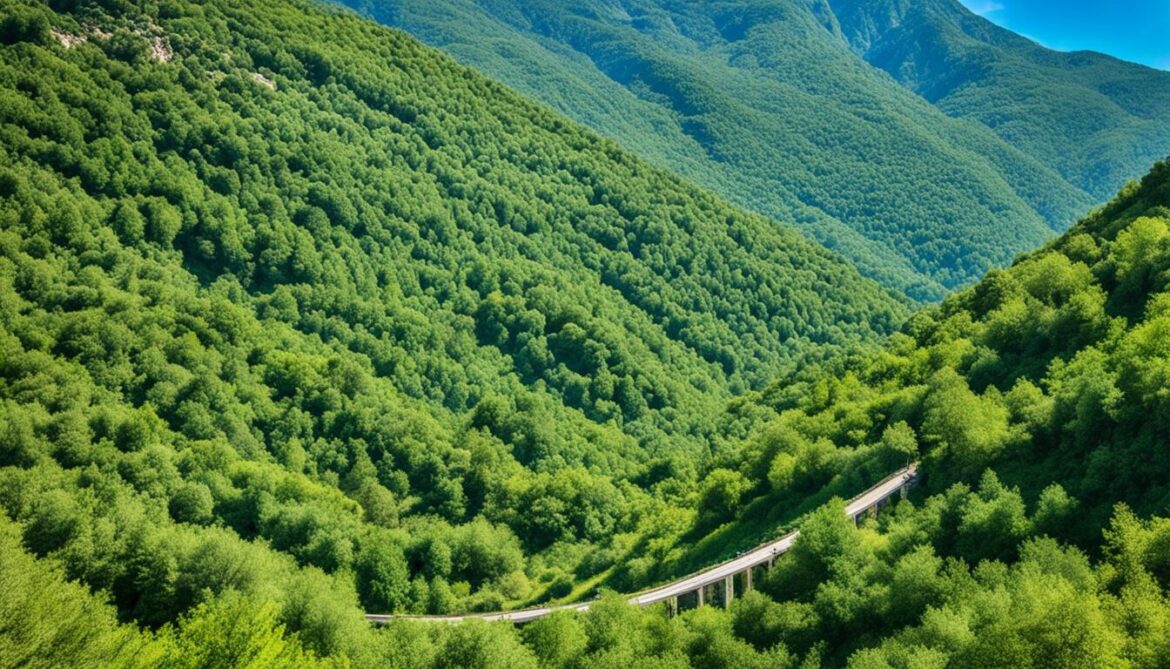
Threatened Species in Albania
Albania’s unique biodiversity is facing numerous threats that endanger its delicate balance. Habitat loss, climate change, and illegal hunting pose significant risks to the survival of many species. Conservation initiatives are essential to protect these vulnerable animals and preserve Albania’s natural heritage.
One of the endangered species in Albania is the Balkan Lynx (Lynx lynx martinoi). With only around 40 individuals remaining in the country, urgent actions are needed to safeguard their habitats and prevent poaching. The Balkan Lynx, known for its distinctive ear tufts and rugged appearance, plays a crucial role in maintaining the ecological balance of its environment.
“Our efforts are focused on preserving the diminishing population of the Balkan Lynx and creating a safe space for their survival,” says Dr. Lila Biçoku, a leading conservation expert in Albania.
Another threatened species in Albania is the Dalmatian Pelican (Pelecanus crispus). These majestic birds, with their striking white feathers and vibrant orange beaks, are experiencing habitat degradation and disturbance in their breeding and feeding areas. Conservation efforts are underway to protect and restore these crucial habitats and ensure the survival of the Dalmatian Pelican population.
Albania’s flora is also under threat, with the Albanian Oak (Quercus frainetto) facing significant challenges due to deforestation and climate change. The Albanian Oak, with its robust stature and majestic appearance, plays a vital role in providing habitat for numerous animal species and contributing to the overall biodiversity of the region. Conservation initiatives focus on restoring degraded areas and implementing effective protection measures to secure the future of the Albanian Oak forests.

Conservation Initiatives
To address the urgent need for conservation, Albania has implemented a range of initiatives to protect and preserve its threatened species. These include:
- Establishment of protected areas and national parks to safeguard habitats
- Community-based conservation projects involving local communities in wildlife protection efforts
- Collaboration with international organisations to access funding and expertise
- Enforcement of laws and regulations to prevent illegal hunting and habitat destruction
These conservation initiatives aim to mitigate the threats faced by Albania’s endangered and threatened species, ensuring their survival and contributing to the long-term ecological balance of the country.
| Endangered Species | Threats | Conservation Efforts |
|---|---|---|
| Balkan Lynx | Habitat loss, poaching | Protecting habitats, anti-poaching measures |
| Dalmatian Pelican | Habitat degradation, disturbance | Habitat protection and restoration |
| Albanian Oak | Deforestation, climate change | Restoration of degraded areas, habitat protection |
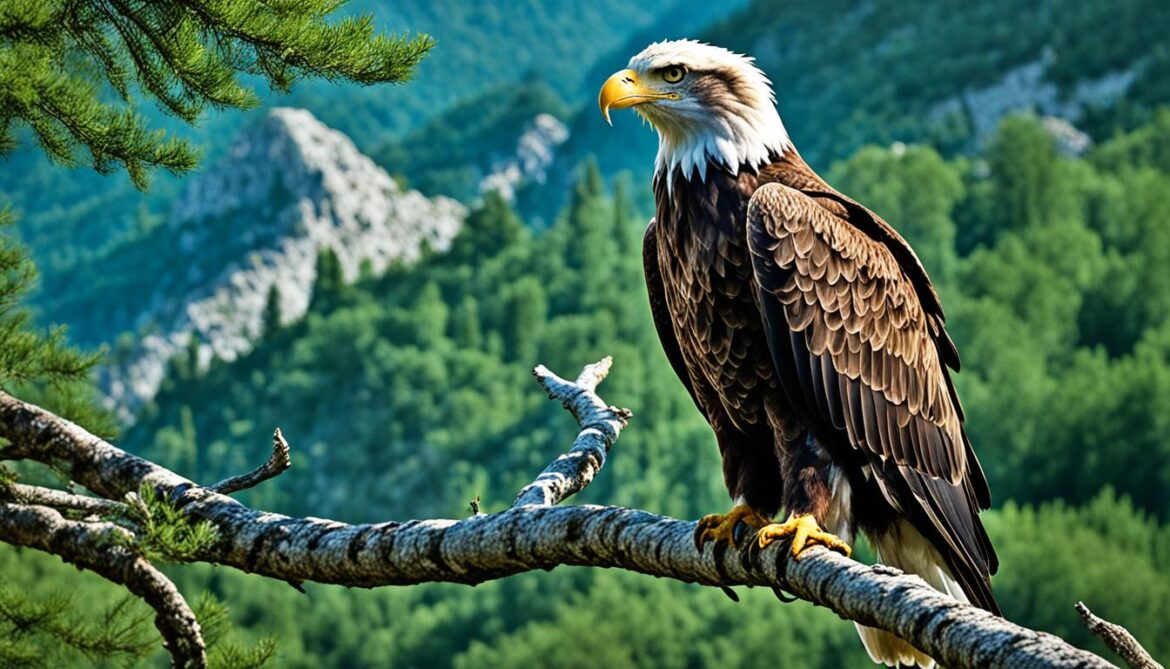
Nature Sanctuaries and Protected Areas in Albania
Albania takes great pride in its efforts to preserve its rich biodiversity through the establishment of nature sanctuaries and protected areas. Covering approximately 18% of the country’s land area, these protected areas play a crucial role in safeguarding the diverse array of animal and plant species that call Albania home.
Two notable protected areas in Albania are the Valbona Valley National Park and the Karaburun-Sazan National Marine Park. Spanning over 8,000 hectares, the Valbona Valley National Park is renowned for its breathtaking landscapes, including dramatic gorges, crystal-clear rivers, and alpine meadows. This protected area is a sanctuary for numerous species, including the endangered Balkan lynx, brown bear, and chamois.
In contrast, the Karaburun-Sazan National Marine Park encompasses over 12,400 hectares of coastal and marine habitats, making it the largest protected marine area in Albania. With its pristine waters, underwater caves, and diverse marine life, including dolphins, monk seals, and sea turtles, this park serves as a vital habitat for numerous aquatic species.
These nature sanctuaries and protected areas in Albania are not merely picturesque sites but critical biodiversity hotspots. They provide a safe haven for endangered species and contribute to the overall health and resilience of Europe’s ecosystems.
The Role of Protected Areas in Biodiversity Conservation
Protected areas are essential for maintaining biodiversity as they offer a variety of habitats and provide refuge for endangered species. By limiting human interference and implementing conservation measures, these areas allow ecosystems to thrive and support sustainable populations of native flora and fauna. This preservation of biodiversity not only helps to maintain ecological balance but also provides countless environmental, economic, and cultural benefits for present and future generations.
| Protected Area | Location | Key Features |
|---|---|---|
| Valbona Valley National Park | Northern Albania | – Spectacular landscapes – Rich biodiversity, including endangered species – Pristine rivers and alpine meadows |
| Karaburun-Sazan National Marine Park | Albanian Riviera | – Largest protected marine area in Albania – Diverse marine life – Pristine coastal and underwater habitats |
These nature sanctuaries and protected areas in Albania serve as reminders of the importance of conservation efforts and the need to protect and cherish our natural heritage. By preserving these valuable ecosystems, Albania is taking significant steps towards a sustainable future and the long-term survival of its unique biodiversity.
The Importance of Environmental Sustainability in Albania
Albania’s remarkable ecosystem diversity is a testament to the country’s unique geography and rich heritage. However, increased human activity and climate change pose significant challenges to preserving this biodiversity. Environmental sustainability in Albania is crucial to protect the environment, reduce pollution, and conserve natural resources.
The country has designated several nature sanctuaries and protected areas, reflecting its commitment to environmental conservation. These areas serve as havens for diverse plant and animal species, safeguarding their habitats and ensuring their survival. By preserving these natural environments, Albania can maintain its rich biodiversity and contribute to the overall health of Europe’s ecosystems.
Environmental sustainability must remain a top priority for individuals, policymakers, and businesses to ensure the long-term well-being of Albania and its people.
Implementing sustainable practices is essential to achieve environmental sustainability in Albania. This includes adopting renewable energy sources, promoting eco-friendly transportation, and practicing responsible waste management. By reducing reliance on fossil fuels and embracing clean energy alternatives, Albania can mitigate the impacts of climate change and reduce its carbon footprint.
In addition, conservation efforts should focus on sustainable agriculture and forestry practices. Promoting organic farming methods and protecting forests from deforestation contribute to soil health, water conservation, and carbon sequestration. These practices not only preserve the environment but also ensure the availability of vital natural resources for future generations.
To raise awareness and encourage sustainable practices, educational initiatives and public campaigns should be implemented. These efforts can empower individuals and communities to make informed decisions about their environmental impact, fostering a culture of sustainability in Albania.
Environmental Sustainability in Action: Eco-Tourism in Albania
An excellent example of environmental sustainability in Albania is the development of eco-tourism. By promoting responsible tourism practices, the country can capitalize on its natural beauty while minimizing negative impacts on the environment.
Eco-tourism initiatives encourage tourists to appreciate Albania’s biodiversity and cultural heritage while respecting the delicate ecosystems they visit. This includes supporting local communities, conserving natural resources, and minimizing waste and pollution. Through eco-tourism, Albania can generate economic opportunities while preserving its natural wonders.
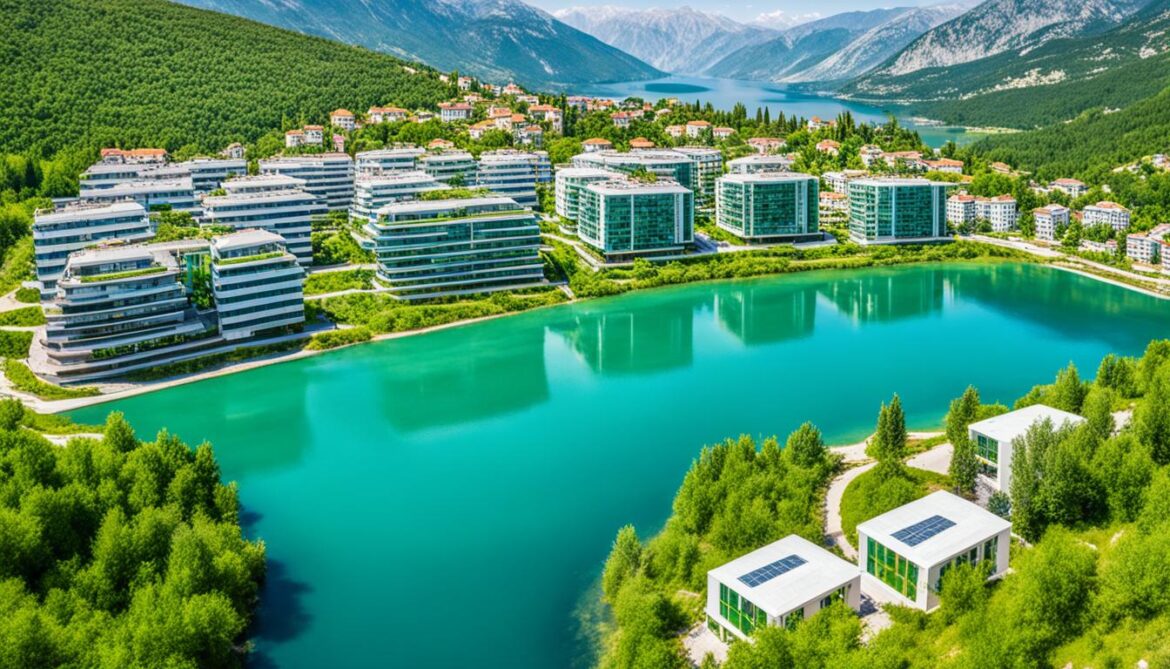
| Eco-Tourism Benefits | Eco-Tourism Practices |
|---|---|
| Preserves natural habitats | Supports local communities |
| Raises environmental awareness | Promotes sustainable transportation |
| Contributes to local economies | Minimizes waste and pollution |
| Fosters cultural exchange | Respects wildlife and biodiversity |
Through eco-tourism and sustainable practices, Albania can harness the potential of its natural resources while ensuring their long-term viability. By embracing environmental sustainability, Albania can protect its biodiversity, preserve its cultural heritage, and create a prosperous future for generations to come.
Albania Top Green Buildings – Discover These Eco-Friendly Architecture Masterpieces
Albania is at the forefront of promoting sustainable architecture and eco-friendly construction practices. The country has embraced the concept of green buildings, which are exemplary models of sustainable infrastructure, energy conservation, and carbon footprint reduction. These architectural masterpieces prioritize environmental design, energy efficiency, and the use of eco-friendly materials to create a greener future for Albania and the planet. Let’s explore some of the top green buildings in Albania that are leading the way in sustainable development.
One of the remarkable green buildings in Albania is the X Building in Tirana. Designed with a focus on energy efficiency, this architectural gem incorporates sustainable features such as solar panels, rainwater harvesting systems, and natural ventilation. The use of eco-friendly materials, including recycled and locally sourced materials, further enhances its sustainability credentials. The X Building showcases how sustainable architecture can seamlessly blend with the urban landscape while reducing environmental impact.
“The X Building in Tirana is a shining example of sustainable architecture, demonstrating how eco-friendly design can be visually stunning and environmentally responsible.”
Another outstanding green building in Albania is the Sustainable Tower in Durres. This iconic structure combines innovative design with sustainable practices, such as high-performance insulation, energy-efficient lighting, and a green roof that promotes biodiversity. The Sustainable Tower embodies the principles of sustainable architecture, creating a harmonious balance between functionality, aesthetics, and environmental responsibility.
One of the notable features of green buildings in Albania is their commitment to energy conservation. The Bank of Albania Headquarters in Tirana is a prime example of energy-efficient design. The building incorporates cutting-edge technologies, including smart lighting systems, efficient HVAC systems, and advanced insulation techniques, to significantly reduce energy consumption. By prioritizing energy efficiency, the Bank of Albania Headquarters sets an inspiring example for sustainable construction practices.
Albania’s green buildings not only prioritize sustainability but also seamlessly blend with the surrounding environment. The Albanian National Library in Tirana is a testament to this fusion of architecture and nature. With its green rooftop garden and extensive use of natural light, the library provides a tranquil retreat while reducing energy demand. This eco-friendly approach creates a harmonious relationship between the built environment and the natural landscape.
“The Albanian National Library beautifully showcases how sustainable architecture can coexist with nature, providing a serene space for learning and reflection.”
Sustainable Tower, Durres

| Name of Green Building | Location | Key Features | Architect |
|---|---|---|---|
| X Building | Tirana | Solar panels, rainwater harvesting, natural ventilation, eco-friendly materials | Architect A |
| Sustainable Tower | Durres | High-performance insulation, energy-efficient lighting, green roof | Architect B |
| Bank of Albania Headquarters | Tirana | Advanced technologies, smart lighting systems, efficient HVAC | Architect C |
| Albanian National Library | Tirana | Green rooftop garden, extensive use of natural light | Architect D |
Your Ultimate Guide to Green Building in Albania
Green building practices, sustainable construction, and energy-efficient buildings are essential considerations in Albania as the country aims to prioritize sustainability and minimize its environmental impact. Implementing eco-friendly architecture and adopting green building practices can significantly contribute to a greener future for Albania.
Principles of Green Building
Green building in Albania is grounded in the principles of environmental sustainability. By incorporating these principles into architectural design and construction practices, buildings can be more energy-efficient, environmentally friendly, and cost-effective in the long run.
- Use of renewable energy sources such as solar panels to reduce reliance on non-renewable energy.
- Efficient insulation and smart building design to minimize energy consumption and optimize heating and cooling systems.
- Maximizing natural light and ventilation to reduce the need for artificial lighting and ventilation systems.
- Incorporating rainwater harvesting systems to conserve water resources.
- Selection of sustainable and locally sourced materials that have a minimal carbon footprint.
- Implementing waste reduction and recycling practices during construction and throughout the building’s lifecycle.
The Benefits of Green Building
Embracing green building practices in Albania offers numerous benefits, including:
- Reduced energy consumption and lower utility bills.
- Improved indoor air quality and occupant health.
- Enhanced resilience to climate change.
- Increased property value and market demand for sustainable buildings.
- Contribution to Albania’s overall environmental sustainability goals.
Examples of Green Building in Albania
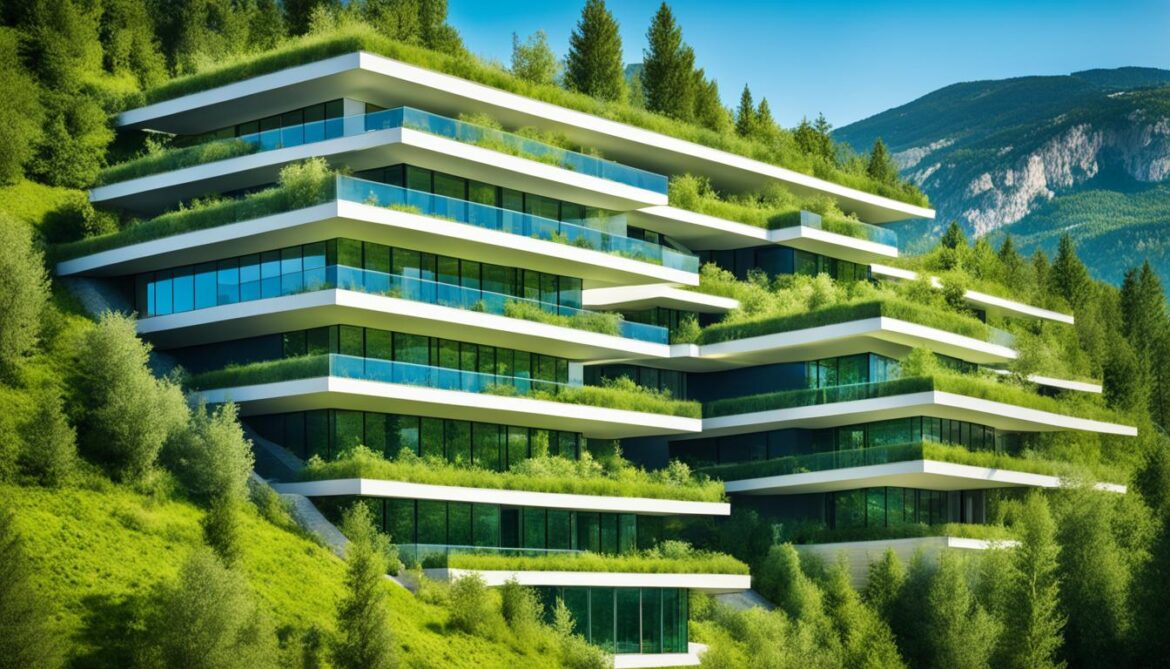
Albania has numerous examples of green buildings that highlight the country’s commitment to sustainability. These buildings showcase innovative design, energy-efficient systems, and the use of eco-friendly materials.
“Green buildings are not only environmentally responsible but also economically beneficial. They not only minimize the impact on the environment but also provide a healthier and more comfortable living and working environment for occupants.” – Architect Maria Petrova
| Building Name | Location | Features |
|---|---|---|
| Sustainable Office Tower | Tirana | Utilizes solar power and incorporates rainwater harvesting systems. |
| Eco-Residential Complex | Durres | Applies passive design strategies for natural heating and cooling. |
| Green Education Center | Shkodra | Maximizes natural light and incorporates sustainable materials. |
These buildings serve as inspiring examples for architects, builders, and individuals seeking to adopt green building practices in Albania.
Taking the Next Step towards Green Building
Whether you are an architect, builder, or individual interested in contributing to the green building movement in Albania, there are practical steps you can take:
- Educate yourself about green building principles and best practices.
- Collaborate with sustainability experts, architects, and builders to implement green design strategies.
- Advocate for green building regulations and incentives to encourage widespread adoption.
- Support local businesses and manufacturers that prioritize sustainable materials and practices.
- Engage in ongoing research and innovation to further advance green building in Albania.
By collectively embracing green building practices, Albania can pave the way towards a sustainable future that balances environmental responsibility with economic growth.
Teams shortlisted to design Albania’s Unesco site center
Four teams led by architects from Japan, Finland, France, and the UK have been shortlisted to design a visitor center for Butrint National Park, a UNESCO World Heritage Site in Albania. The visitor center will serve as a hub for educating visitors about the site’s cultural and natural heritage, showcasing Albania’s unique biodiversity and sustainable practices. The design competition aims to create an architectural masterpiece that harmonizes with the surrounding environment and celebrates Albania’s rich history and biodiversity.
The shortlisted teams bring a wealth of experience and innovative design approach, ensuring the visitor center will be a standout landmark. Each team will present their proposals, highlighting their vision for the center’s architectural design, functionality, and integration with the natural landscape.
Shortlisted Architectural Teams:
- Team Japan: Led by architect Hiroshi Takayama, renowned for his eco-centric designs that blend traditional Japanese aesthetics with sustainable features.
- Team Finland: Led by architect Maija Leppänen, known for her expertise in creating modern architectural spaces that seamlessly merge with the surrounding nature.
- Team France: Led by architect Aurélie Martinez, recognized for her innovative approach to sustainable design, integrating the principles of bioclimatic architecture.
- Team UK: Led by architect James Thompson, celebrated for his ability to create visually striking structures that harmonize with their surroundings and minimize environmental impact.
The chosen design will not only serve as a gateway to Butrint National Park but also as a symbol of Albania’s commitment to environmental preservation and sustainable architectural practices. By integrating the visitor center with the natural landscape and utilizing eco-friendly materials and energy-efficient technologies, Albania aims to set an example for future architectural projects nationwide.
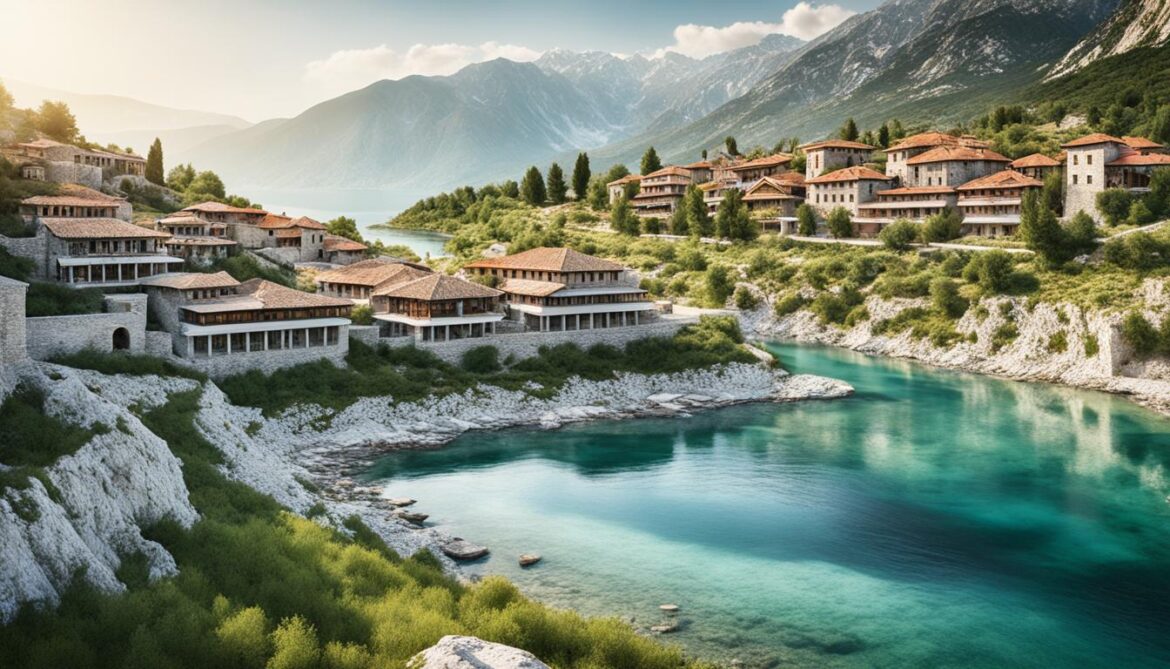
Conclusion
Albania’s biodiversity is a true treasure that must be protected for the future. Through dedicated wildlife preservation, conservation efforts, and a commitment to environmental sustainability, Albania can ensure the thriving of its natural wonders. The establishment of protected areas and the development of sustainable architecture showcase the country’s determination to safeguard its natural heritage.
Preserving Albania’s biodiversity is not only crucial for the survival of individual species but also for the overall health of ecosystems. By working together, we can create a sustainable future for all, where Albania’s rich biodiversity continues to flourish. It is our responsibility to conserve and protect Albania’s natural treasures, ensuring the well-being of both present and future generations.
With a focus on biodiversity conservation, environmental sustainability, and future sustainability, Albania can pave the way for a greener and more harmonious future. By valuing and protecting its ecosystems and adopting eco-friendly practices, Albania can create a sustainable and resilient environment for its people and the diverse species that call it home.








